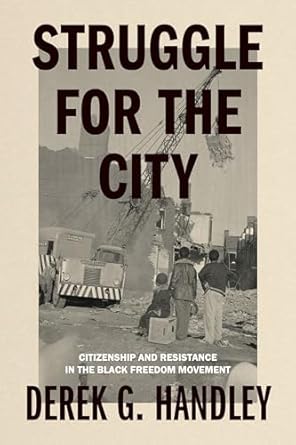The Book
Struggle for the City: Citizenship and Resistance in the Black Freedom Movement
The Author(s)
Derek G. Handley

Derek G. Handley’s Struggle for the City: Citizenship and Resistance in the Black Freedom Movement reframes the story of urban renewal and its effects on the Black communities in Pittsburgh, Pennsylvania; St. Paul, Minnesota; and Milwaukee, Wisconsin as rhetorical battles. While all three communities suffered losses—the Lower Hill, Rondo/St. Anthony, and Bronzeville neighborhoods—Handley illustrates through chapters one, two, and three, respectively, how the people were not “passive victims of urban renewal,” but instead agentive leaders who created lasting change and “laid the groundwork for future urban planning victories.”[1] Handley challenges the master narratives of the mid-twentieth century Black Freedom Movement that prioritize the U.S. South geographically and the language of government officials politically. By attending to how regular people in these neighborhoods resisted their destruction, Handley exposes what he calls “Black Rhetorical Citizenship.” Through the analysis of grassroots organizations’ tactics in Pittsburgh, St. Paul, and Milwaukee, the book offers a counternarrative that demonstrates how savvy these groups were at rewriting urban renewal rhetoric.
This book is a valuable history of urban renewal tactics. Because lawmakers avoided any mention of race, many African Americans cosigned urban renewal as an opportunity for equity in the early days. Quickly, however, Black residents learned that words like “blight” referred to them as the disease infecting the city. Urban renewal in these Northern cities happened in the 1950s and early 1960s, so Congress had not yet passed the Civil Rights Act. The communities saw that the city systematically destroying the only place Black people were permitted to live (due to covenants and other racist housing policies) meant that urban renewal was meant to remove them from these cities, out of neighborhoods they had built for decades.
Handley humanizes the resistance efforts through careful archival research to highlight the preachers, barbers, building and business owners, and other regular people who tried valiantly to save their neighborhoods. Because of his interested in rhetorical citizenship, Handley shares tactics others would overlook: the local Black newspaper in Pittsburgh ran a series of stories about the Hill District from the perspective of its residents; a barbershop owner in St. Paul lobbied vigorously for I-94 to be a depressed highway so the neighborhood could stay connected through a series of bridges; and a group of community members and college professors collectively created leadership seminars for Black Milwaukeeans fighting to keep Bronzeville. Furthermore, Handley sees that these groups had success in keeping their neighborhoods and communities alive even when houses were destroyed and highways paved.
The last chapter of the book reads the monuments to these neighborhoods—The Freedom Corner Memorial, Rondo Plaza, and the Walnut Street Bridge—offering some of the most insightful and useful theorizing in the book around critical memory, rhetorical place making, and civic engagement. Scholars interested in how marginalized groups create successful and lasting resistance will gain much from this chapter. Handley’s spatial analysis of the memorials offers a blueprint of the value and breadth of sophisticated rhetorical analysis. The conclusion calls the reader to action: to attend to grassroots narratives instead of official ones, to look for intercommunal reciprocity as a style of leadership, and be critical of how gentrification in the twenty-first century is putting the same spaces and peoples at risk.
Choosing to study these smaller cities and to document the work there is a significant contribution. While those who study urban history know that Detroit, Chicago, and New Orleans have large, historical, and politically active Black communities, fewer people know that the same is true of Pittsburgh, St. Paul, and Milwaukee. Each time Handley describes the rhetorical work of a neighborhood, a billboard, a model, a map, or a memorial, he provides images immediately in the text, helping the readers see these acts. The book as a whole is effortlessly accessible because each chapter has many short subsections, which will also make assigning reading from it easy.
The book would be stronger if each of the body chapters about the cities were more parallel in construction: some chapters give a useful history of the development of the Black communities there, some don’t; one chapter has a conclusion, the others don’t; and the chapter on Milwaukee is comparatively short.
The book’s topic, thoughtful analysis, and ease of reading remain. The work should be especially meaningful for historians, rhetoricians, sociologists, and cultural and Black studies scholars. The overall message of the book—that even when there is material loss, there is often still rhetorical gain—is a light of hope in the current atmosphere.
[1] Derek G. Handley, Struggle for the City: Citizenship and Resistance in the Black Freedom Movement. (University Park, PA: The Pennsylvania State University Press, 2024): 90 and 89.
About the Reviewer
Megan E. Geigner is a cultural studies and theatre scholar interested in the performance of ethnicity and citizenship. She is the coauthor of the textbooks Theatre: The Lively Art, Living Theatre, and The Theatre Experience; co-editor and contributor to Makeshift Chicago Stages and Theatre After Empire; and author of many book chapters and articles. She is an associate professor of instruction in the Cook Family Writing Program at Northwestern University.

0